BEHAVIOR OF PARAMAGNETIC SUBSTANCES IN AN EXTERNAL MAGNETIC FIELD
When a paramagnetic substance is placed in an external magnetic field the dipoles are partially aligned in the direction of the applied field.
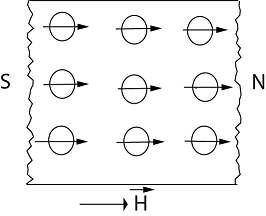
Therefore the substance is feebly magnetized in the direction of the applied magnetic field. This result into a weak attractive force on the substances.
In the absence of the external magnetic field the dipoles of the paramagnetic substances are randomly oriented and therefore the net magnetic moment of the substance is zero.
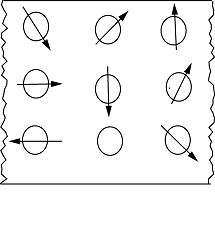
Hence the substance does not exhibit Para – magnetism
PROPERTIES OF PARAMAGNETIC SUBSTANCES
1. The relative permeability of a paramagnetic substance is always more than 1

The result field B inside a paramagnetic substance is more than the external field Bo

2. The magnetic susceptibility of the paramagnetic substance has small positive value
It is because  and
and 
3. The magnetic susceptibility of a paramagnetic material varies inversely as the absolute temperature

Paramagnetism is quite sensitive to temperature. The lower the temperature the stronger is the paramagnetism and vice versa
4. A paramagnetic substance is feebly attracted by the strong magnet. It is because a paramagnetic substance develops weak magnetization in the direction of the applied external magnetic field
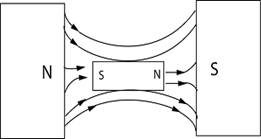
5. When a paramagnetic substance is placed in a magnetic field, the magnetic field lines of force prefer to pass through the substance rather than through air.

Therefore the resultant field B inside the substance is more than the external field Bo
FERROMAGNETIC MATERIALS
Are the materials which when placed in a magnetic field are strongly magnetic in the direction of the applied field.
Ferromagnetic substances includes
· Iron
· Cobalt
· Nickel
· Fe2O3
· Gadolinium
Since the strong induced magnetic field is in the direction of the applied magnetic field, the resultant magnetic field inside the ferromagnetic substance is very large compared to external field
It is clear that ferromagnetism is very stronger form of magnetism. When external field (magnetic field) is removed some ferromagnetic substances retain magnetism
PROPERTIES OF FERROMAGNETIC SUBSTANCES
1. The relative permeability ( ) of the ferromagnetic substance is very large
) of the ferromagnetic substance is very large
Now


The resultant field B inside a ferromagnetic substance is very large as compared to the external filed Bo
2. The magnetic susceptibility ( ) of a ferromagnetic substance is positive has a very high value.
) of a ferromagnetic substance is positive has a very high value.
It is because  = 1
= 1
 and
and  1 for this reason, ferromagnetic substance can be magnetized easily and strongly.
1 for this reason, ferromagnetic substance can be magnetized easily and strongly.
3. A ferromagnetic substance is strongly attracted by a magnet
4. When a rod of ferromagnetic substance is suspended in a uniform magnetic field, it quickly aligns itself in the direction of the field.
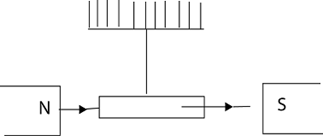
5. They retain their magnetization even when their magnetizing force is removed.
6. When a ferromagnetic substance is placed in a magnetic field the magnetic field lines tend to crowd into the substance
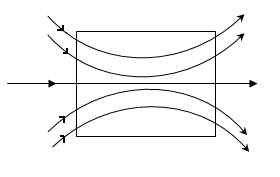
DOMAIN
Is the region of the space over which the magnetic dipole movements of the atoms are aligned in the same direction.
(i) In the absence of the external magnetic field the domain of the ferromagnetic materials are randomly oriented as shown below.
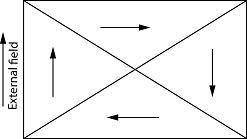
In other words, within the domain all the magnetic moments are aligned in the same direction but different domains are oriented randomly in different direction.
The result is that one domain cancels the effect of the other so that the net magnetic moment in the material is zero.
Therefore a ferromagnetic material does not exhibit magnetism in the normal state
(ii) When a ferromagnetic substance is placed in an external magnetic field a net magnetic moment develops the substance.
This can occur in two ways
(a) By displacement of boundaries of the domains i.e. the domains that already happen to be aligned with the applied field may grow in size whereas those oriented opposite to the external field reduce in size.
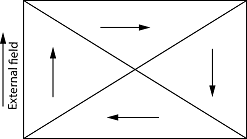
(b) By the rotation of the domains i.e. the domains may rotate so that their magnetic moments are more or less aligned in the direction of the magnetic field.
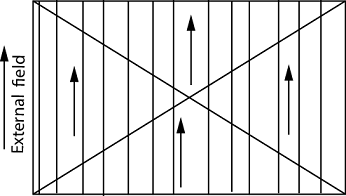
The result is that there is net magnetic moment in the material in the direction of the applied field.
Since the degree of alignment is very large even for a small external magnetic field the magnetic field produced in ferromagnetic material is often much greater than the external field.
CURIE
TEMPERATURE
Is the temperature at which the ferromagnetic substance becomes paramagnetic
It is also known as Curie point of the substance
Ferromagnetism decreases with the increases in temperature
When a ferromagnetic substance is heated magnetization decreases because random thermal motions tend to destroy the alignment of the domains
At sufficiently high temperature the ferromagnetic property of the substance suddenly disappears and the substance becomes paramagnetic.
In a ferromagnetic substance the atom appear to be grouped magnetically into what are called domains.
This occurs because the magnetic dipole moments of atoms of a paramagnetic substance exert strong force on their neighbor so that over a small region of space the moments are aligned with each other even with no external field.
Above Curie temperature these forces disappear and ferromagnetic substances become paramagnetic.
HYSTERESIS
Is the phenomenon of lagging of flux density (B) behind the magnetic force (H) in ferromagnetic materials subjected to cycles of magnetization.
When a ferromagnetic substance e.g. iron is subjected to cycle of magnetization (i.e. it is magnetized first in one direction and then in the other) it is found that flux density B in the materials lags behind the applied magnetizing force H.
This phenomenon is known as Hysteresis.
If a piece of ferromagnetic material is subjected to one cycle of magnetization the result B-H curve is a closed loop a b c d e f
a called Hysteresis loop.
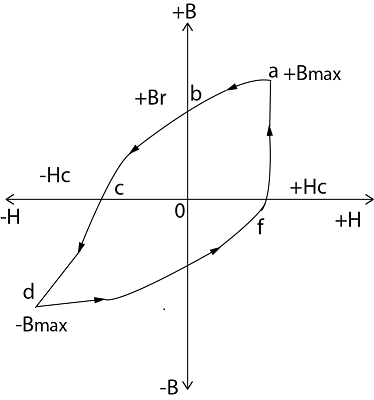
B always lags behind H, Thus at point b, H is zero but flux density B has a finite positive value ob similarly at point e, H is zero but flux density B has a finite negative value X .
HYSTERESIS LOOP
Consider an Iron cored toroid carrying current I
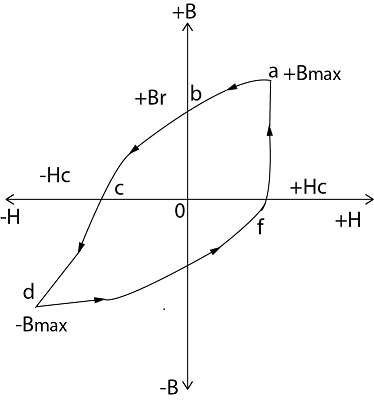
If N is the total number of turn and l the length of toroid, then magnetizing force is

The value of H can be changed by varying current in the coil
Consider that when the Iron cored toroid is subjected to a cycle of magnetization the resultant B- H curve traces a loop a b c d e f a called hysteresis loop
(i) To start with the toroid is unmagnetised and its situation is represented by point O in graph
As H is increased ( by increasing current I),B increases along  and reaches its saturation value
and reaches its saturation value  at a this stage
at a this stage
(i) all the domains are aligned
(ii) If now H is gradually reduced by decreasing current in the toroid it is found that curve follows the path  instead of
instead of 
At point b, H = O but flux density in the material has a finite value of +Br called residual flux density
REMANENCE
Is the flux density left behind in the sample after the removal of the magnetizing force (H). It is also called Residual magnetism or retentively.
B lags behind H. This effect is called Hysteresis
(iii) In order to reduce flux density in the material to zero, it is necessary to apply H in the reverse direction
This can be done by reversing the current in the toroid
When H is gradually increased in the reverse direction the curve follows the path 
At point C, B =O and H = -HC, the value of H needed to wipe out residual magnetism is called coercive force it.